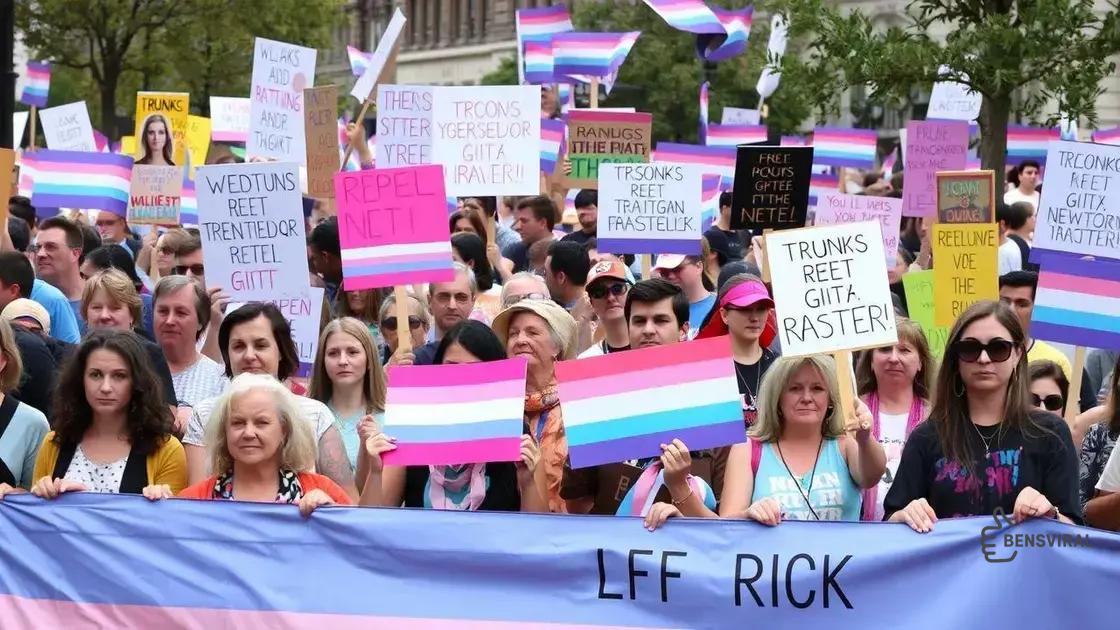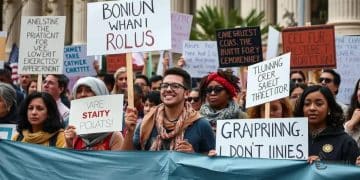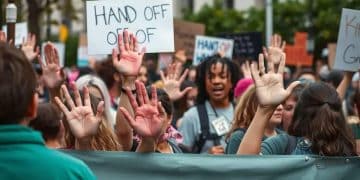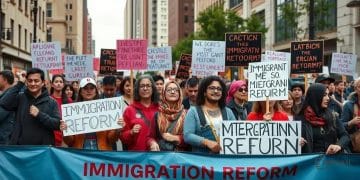Rallies advocating for transgender rights: a call for change

Rallies advocating for transgender rights create vital community support, empower individuals, and raise awareness about transgender issues while facing challenges such as opposition, logistics, and media representation.
Rallies advocating for transgender rights represent a vital movement towards equality and acceptance. These events not only raise awareness but also foster a sense of community that empowers individuals. Have you considered how you can be part of this important dialogue?
The significance of rallies for transgender rights
Rallies for transgender rights play a crucial role in promoting awareness and understanding of the issues faced by the transgender community. These events are not just about gathering together; they are about standing in solidarity and making a loud statement for equality.
In recent years, the significance of such rallies has grown as more individuals and organizations join the fight for transgender rights. Many participants gather to voice their opinions and share their stories, making these events deeply personal and impactful.
Empowering the Community
One major aspect of rallies is their ability to empower the transgender community. They create a space where individuals can feel safe and supported. This feeling of unity strengthens the fight for rights and helps people realize they are not alone in their struggles.
Additionally, these rallies send a clear message to lawmakers and the public about the need for change. With every banner raised and every chant shouted, the demand for justice and recognition becomes louder.
Creating Awareness
Rallies also serve a vital educational purpose. They inform the public about the challenges that transgender individuals face daily. Here are some key points discussed at these events:
- The importance of legal protections against discrimination.
- Access to healthcare for transgender individuals.
- The impact of social stigma and violence.
- Resources available for support and advocacy.
By sharing these issues, rallies create a better understanding among the general public. They challenge misconceptions and foster conversations that are essential for societal change.
Furthermore, media coverage of these events helps to amplify their message, reaching a wider audience beyond those in attendance. This expanded visibility can lead to increased support and activism in various communities.
Building Alliances
Rallies are also an opportunity to build alliances with other social justice movements. When people come together for a common cause, they can draw attention to the interconnected nature of various struggles. This collaboration strengthens the overall fight for rights and makes it easier to advocate for a more equitable society for everyone.
Recent trends in transgender advocacy
In recent years, the landscape of transgender advocacy has evolved significantly. Activists and organizations are adopting new strategies to promote awareness and support for transgender rights. Understanding these trends helps in concerting efforts for equality.
One notable trend is the increasing visibility of transgender individuals in media and politics. More people are using their platforms to advocate for change, representing their communities with authenticity. This representation fosters acceptance and understanding, paving the way for broader support.
Grassroots Movements
Grassroots movements have gained momentum as community-led initiatives focus on local issues affecting transgender individuals. By organizing rallies, workshops, and educational events, activists can create change from the ground up. These efforts often emphasize:
- Community involvement and empowerment.
- Direct engagement with local leaders and policymakers.
- The importance of safe spaces for discussions and support.
- Access to resources for marginalized groups.
These grassroots efforts help to give a voice to those who may feel unheard in larger political discussions, emphasizing the need for local action.
The Role of Technology
Another emerging trend is the utilization of technology for advocacy. Social media has become a powerful tool for transgender advocacy, allowing activists to connect with a global audience. Online campaigns can go viral, spreading messages and creating awareness much faster than traditional methods.
Moreover, various organizations are using technology to provide virtual resources, such as webinars and online support groups. This accessibility allows individuals from various backgrounds to participate and learn about transgender rights no matter their location.
Furthermore, the rise of online fundraising campaigns has enabled many organizations to secure funding and support for their initiatives. This reliance on technology is changing the way advocacy is conducted and offers new opportunities for connection.
Intersectionality in Advocacy
Finally, there is an increasing focus on intersectionality within transgender advocacy. Activists recognize the importance of addressing how different identities—such as race, economic status, and sexuality—intersect with the experiences of being transgender. This awareness fosters inclusivity, ensuring that all voices are represented in the fight for rights.
Embracing intersectionality helps build solidarity among various movements and reinforces the idea that everyone deserves equal rights and recognition.
How community support impacts transgender rights

Community support plays a vital role in advancing transgender rights. When neighborhoods and groups come together to advocate for each other, the impact can be profound. This support empowers transgender individuals and fosters an environment of acceptance and understanding.
One example is how local communities organize events and initiatives to raise awareness. These activities can create safe spaces for discussions about transgender issues. They also help to educate those who may not understand the unique challenges faced by transgender individuals.
Building a Supportive Environment
Support from community members often results in a more welcoming atmosphere. Families, friends, and allies can actively participate in events, showing their solidarity. This public demonstration of support can lead to:
- Increased visibility of transgender rights.
- Political pressure for local lawmakers to implement protective legislation.
- A stronger sense of belonging among transgender individuals.
- Access to support networks and resources.
When communities rally together, they create a united front that requests equal treatment and rights.
Advocacy Through Events
Community support is also visible during advocacy events like rallies and pride parades. These gatherings often see a diverse group of individuals participating, which sends a strong message of unity. Such events encourage people to share their stories and experiences, which aids in humanizing the issues at hand.
Participation in these events can mobilize resources for local organizations that support transgender rights. The community can help by volunteering time or donating funds to initiatives that educate people about these important issues.
Furthermore, local businesses may also show support by sponsoring events or offering their venues for community discussions. Such partnerships enhance the visibility of transgender rights and encourage more people to get involved.
Overcoming Stigma
Community support is crucial for combating stigma surrounding transgender individuals. When communities actively work to change negative perceptions, they help pave the way for acceptance. Engagement in conversations about transgender issues within households and educational institutions can alter viewpoints.
As more individuals understand the importance of gender identity and expression, barriers within society begin to dissolve. Community support acts as a foundation upon which transgender rights can flourish.
Challenges faced during transgender rights rallies
Rallies advocating for transgender rights face several challenges that can impact their effectiveness. Understanding these challenges is essential for improving future events and ensuring that the message of equality is heard loud and clear.
One significant challenge is the presence of opposition groups. At many rallies, activists encounter individuals or organizations that oppose transgender rights. This opposition can lead to confrontations, which may distract from the primary goals of the event. To address this, organizers often focus on creating a safe and secure environment for participants.
Logistical Difficulties
Another issue is the logistical planning required for these rallies. Organizers must secure permits, manage crowd control, and ensure adequate safety measures are in place. This can be a daunting task, especially when dealing with large groups of people. Events can be disrupted if these logistics are not handled properly.
Some common logistical challenges include:
- Securing adequate funding for the event.
- Coordinating transportation and access to the venue.
- Managing sound systems and stages for speeches.
- Providing necessary materials such as banners and informational pamphlets.
When these aspects are not well-planned, the rally may lose momentum and fail to convey its message effectively.
Weather Conditions and Timing
Weather conditions also pose a challenge for rallies. Inclement weather can deter participants from attending, which affects turnout. Organizers often schedule events during seasons with favorable weather, but unforeseen conditions can still arise, causing plan adjustments.
Moreover, timing plays a critical role in rally attendance. Competing events or holidays may result in lower participation. It’s important for organizers to consider local calendars and community events when planning a rally.
Media Representation
How the media portrays these rallies is another concern. Negative or misleading coverage can impact public perception of the transgender rights movement. When reports focus on conflict or controversial aspects, they can overshadow the positive messages that advocates wish to convey.
To counteract this, rally organizers often reach out to media outlets ahead of time, providing clear and positive messaging about the event’s purpose. Building relationships with local journalists can help ensure accurate and supportive representation.
Despite these challenges, dedicated activists continue to push forward in the fight for transgender rights. Overcoming obstacles is part of the journey toward equality and acceptance for all.
Ways to get involved in local advocacy
Getting involved in local advocacy for transgender rights can make a significant impact on your community. There are many ways individuals can support this vital cause. Whether you are new to activism or looking to deepen your involvement, every effort counts.
One way to contribute is by joining local organizations that focus on transgender rights. These groups often welcome new members and provide training on advocacy methods. Participating in their events and initiatives can help amplify the message of equality and acceptance.
Volunteer Opportunities
Volunteering is a fantastic way to engage with the community. Here are some activities that you can consider:
- Assisting with event organization for rallies and awareness programs.
- Helping with outreach to educate others about transgender issues.
- Providing support for local transgender individuals in need.
- Joining fundraising efforts to support advocacy organizations.
These volunteer efforts can help build a stronger community and foster connections among individuals who share similar goals.
Attend Local Events
Participating in local events is another great way to get involved. Attending rallies, workshops, or informational sessions offers you a chance to learn more and meet like-minded individuals. These events can also serve as platforms for discussing pressing issues related to transgender rights.
Moreover, when you attend events, you show your support, which contributes to a larger movement for acceptance. Your presence can encourage others to join and participate.
Engage with Your Community
Engagement doesn’t have to end with events. You can also take action within your own circles, such as schools, workplaces, or social groups. Here are some ideas:
- Start discussions about transgender rights to raise awareness.
- Share resources or information with friends and family.
- Encourage local leaders to create policies that support transgender individuals.
- Participate in or organize educational forums or panels.
Talking about transgender issues helps normalize conversations around gender identity, creating a more inclusive environment.
Overall, engaging in local advocacy for transgender rights can take many forms. From volunteering to community discussions, these efforts contribute to building a supportive network for transgender individuals. Finding your unique way to contribute can help create positive change.
FAQ – Frequently Asked Questions about Advocacy for Transgender Rights
What can I do to support transgender rights in my community?
You can join local organizations, volunteer for events, and engage in conversations to raise awareness about transgender issues.
Are there specific events I can participate in to advocate for transgender rights?
Yes, you can attend rallies, workshops, and educational forums that focus on transgender rights and support.
How can I start discussions about transgender rights with my friends and family?
You can share resources, express your views clearly, and encourage open conversations to help educate others about transgender issues.
Why is community support important for transgender advocacy?
Community support amplifies voices, builds solidarity, and creates a more inclusive environment, which is essential for achieving equality.






